A synthesis essay is an advanced type of an essay you may have to write in college. So, if you’re a little confused, not to worry – you’ve come to the right place.
I’m Tutor Phil, and in this illustrated tutorial, I’ll teach you how to write a synthesis essay, step by step.
So, what is a synthesis essay, and how do you write one? Here is the short answer.
A synthesis essay is an argumentative piece of writing in which the author states and supports a thesis by combining ideas from two or more sources.
Writing a synthesis essay involves three main steps:
- Analyze the main sources
- Form a new thesis by deriving it from the sources
- Support the new thesis using ideas from the main sources and optionally from research
This may sound like a mouthful, but I promise to make the process really simple. That’s why I’ll use diagrams to illustrate the steps. Are you ready? Let’s do this.
Writing a Synthesis Essay in 3 Steps
Let me give you a bird’s eye view of the process before we proceed, because a picture’s worth a thousand words. And then we’ll go through the steps in detail.
In step 1, we must analyze our main sources. This means to break them into parts and identify the main and supporting points.
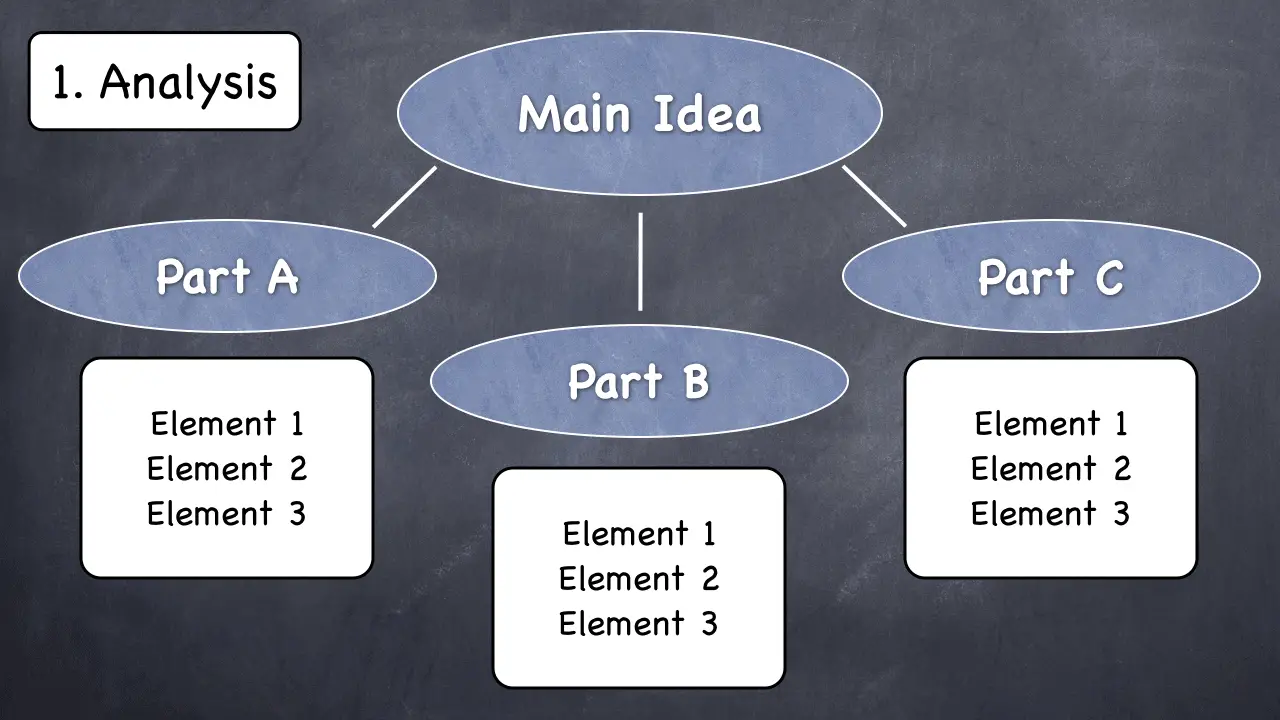
In step 2, we’ll take the main ideas from our main sources and formulate a new thesis based on them.
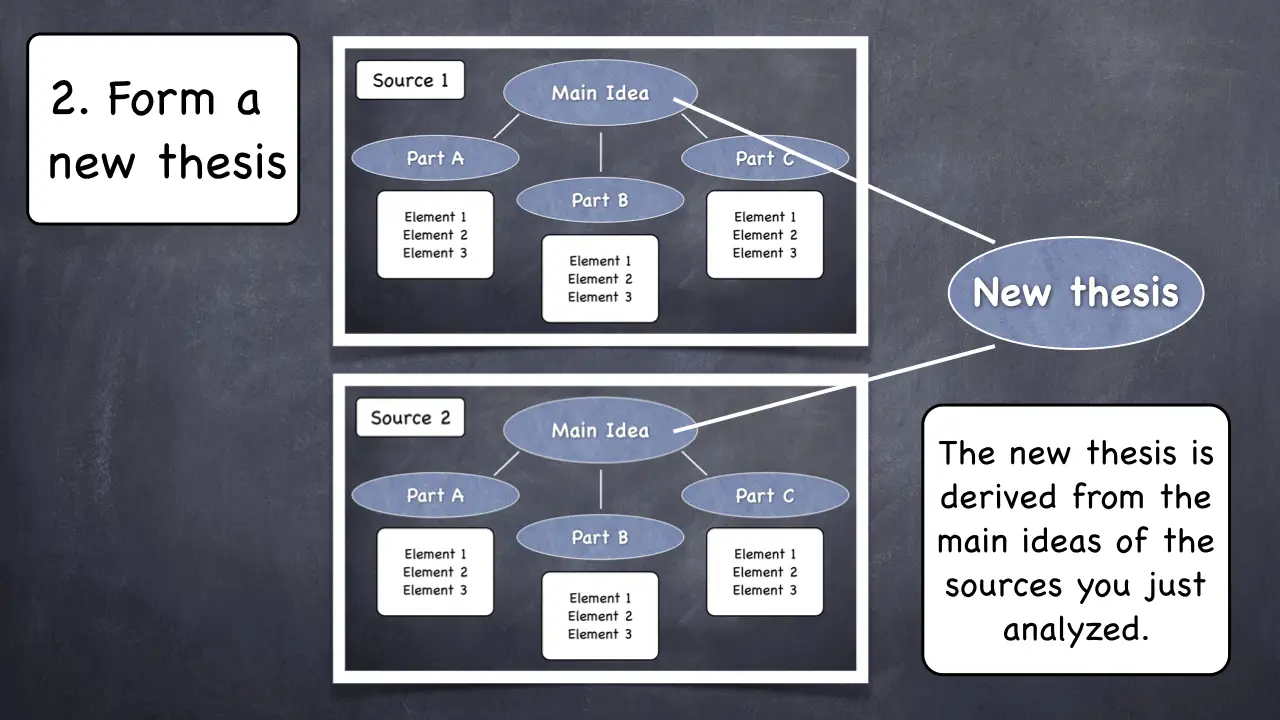
And in step 3, we’ll write the synthesis essay by stating our new main point and supporting it using ideas from the main and possibly from the secondary sources.
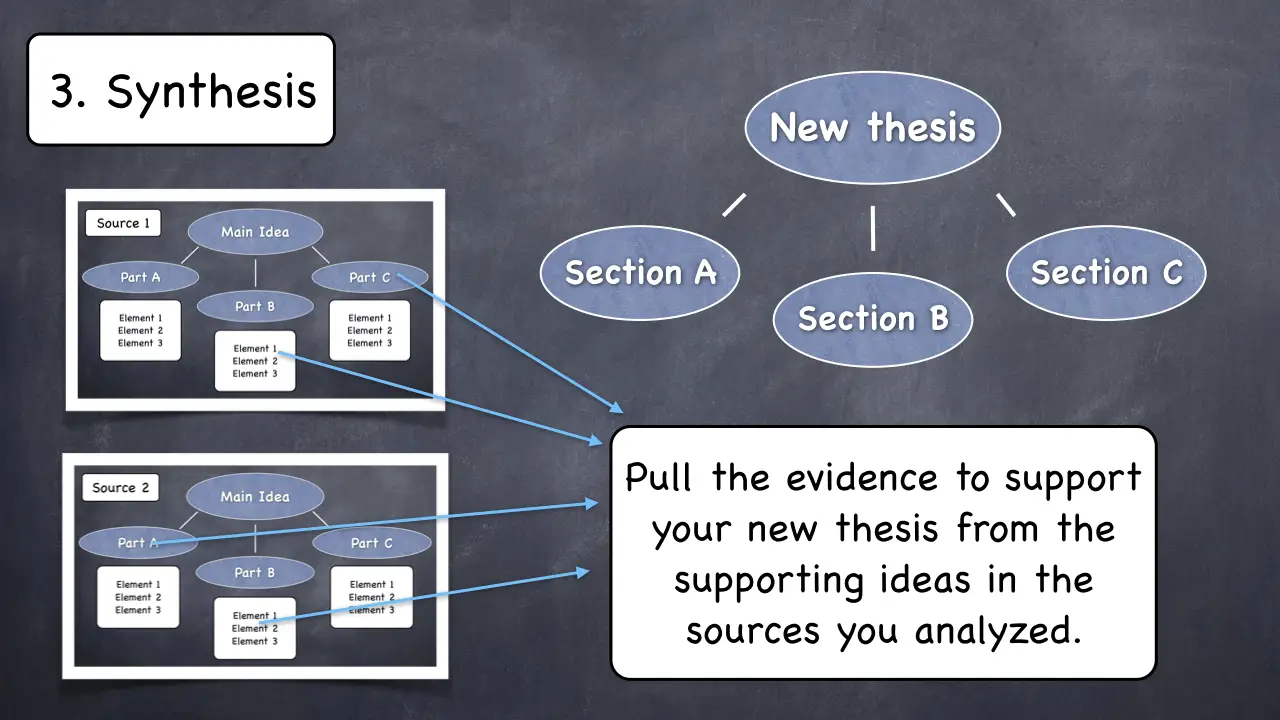
Step 1. Analyze the main sources
Note that the instruction is to analyze the main sources, not all the sources.
The main sources are the pieces that you are trying to synthesize. These could be:
- Articles written by experts on a subject, including scientific papers
- Works of fiction
- Historical primary sources
- Your own previously written essays or papers
All the other sources are secondary. These are most likely peer-reviewed or expert-written articles you can find in databases or openly online.
Secondary sources will help you write the body of the essay because that’s where you will put all the evidence to support your thesis.
Here’s the key point for you to remember:
Don’t try to do a lot of research, collect and read all the sources, and synthesize all of them into one argument.
Doing this would overwhelm you real fast. But a lot of students do it this way, thinking that the more information they have, the easier it will be to get the ideas flowing.
However, you really want to pick two or three main sources which you will synthesize. And then the remaining sources will only serve to support the points you’ll be making in your essay.
Pick Your Main Sources
If your instructor wants you to synthesize two or three particular pieces of writing, then the choice has been made for you. And that’s not bad because it’s one decision you don’t have to make.
Your topic can be an “agree or disagree” type of a prompt. In that case, you simply have to decide on your position first and then complete the steps outlined in this tutorial.
But chances are that your teacher or professor has given you a choice of what to write about in your synthesis essay. Choose two or three main sources, even if your instructor has given you more sources to synthesize.
You don’t need more than two or three main ones. Let the rest of them be supportive, meaning that they will provide material for the body of the essay when you’re ready to write it.
But pick two or three pieces and no more because your first step is to analyze them thoroughly.
It is much better to analyze two sources in detail than to just read through a dozen articles and hope that good ideas will show up.
Remember – all you need is two good ideas to form your thesis, which will be Step 2 in our process.
Here are some criteria for choosing the main sources:
- They must have something in common, such as a subject, theme, or argument
- Choose pieces that you find the most interesting
- Sources that you are already familiar with are great
- Shorter is better than longer
- The easier the source is to read and understand the better
At this point, let’s pick our two sources that we’ll use as examples for the rest of the tutorial.
I’m choosing two sonnets of Shakespeare, for several reasons:
- I’m really familiar with them and have taught one of them in class many times
- They are short and sweet and fun to analyze
- Each one contains a crystal clear argument
- They share subjects and themes
So, we’ll be analyzing and synthesizing two sources. And if you learn this process, you can use it to synthesize as many sources as you want.
Do the Analysis

What does it really mean to analyze something?
Analysis is just a process of:
- Breaking a whole into parts
- Identifying the relationships among the parts
- Deriving one main idea that unites the parts
So, that’s exactly what we’ll do when we analyze the Shakespearean sonnets. Let’s do it.
Shakespeare’s sonnet 18
First, let’s identify its main structure.
This is the most famous of all sonnets of Shakespeare and one of the most famous poems ever written. Let’s do a brief analysis of this sonnet.
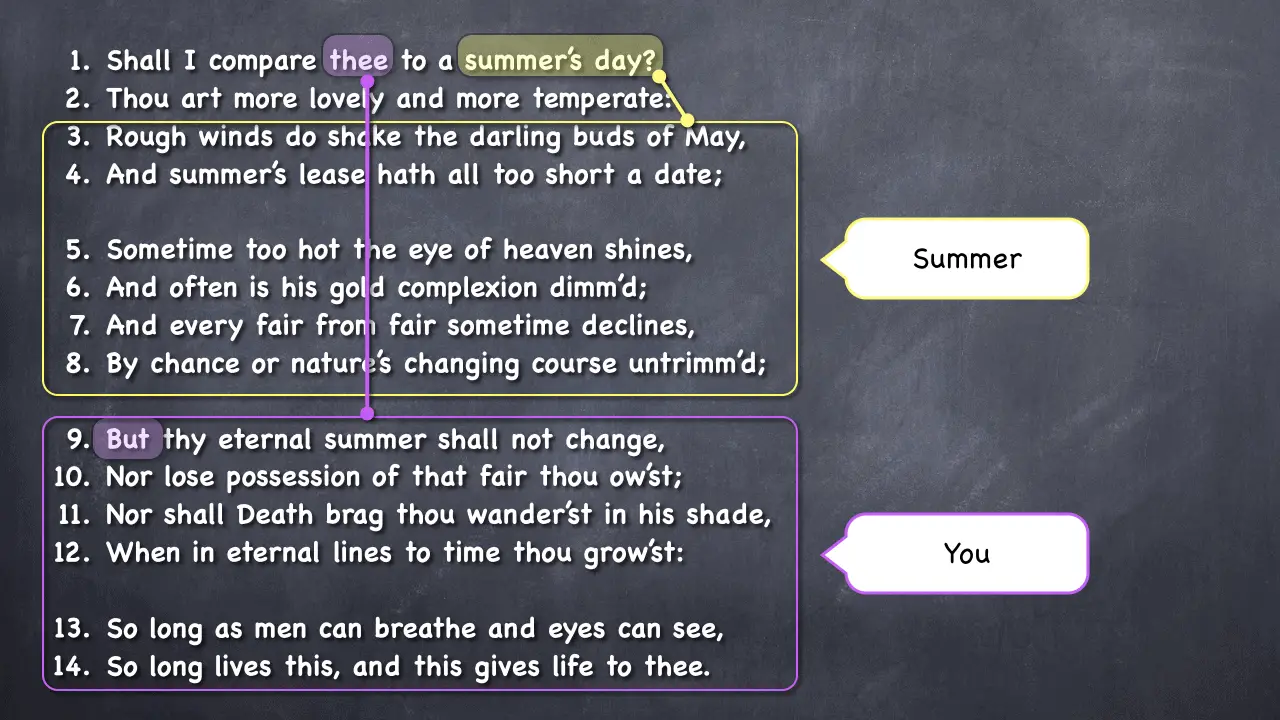
In lines 1 and 2, Shakespeare presents his main argument – that “you,” the subject of the sonnet, are more lovely and mild than a hot summer day.
Shakespeare begins the sonnet by telling the reader immediately that…
- He intends to compare “you” to “the summer”
- “You” are superior to the summer in two ways
- You are more beautiful and more “temperate” (mild)
Great! So, we have the main argument. We also know the main structure of the sonnet. It contains two sections in which Shakespeare accomplished his comparison.
The first section (lines 3-8) is devoted to the summer.
And the second section (lines 9-14) is devoted to the subject, meaning “you.”
As you can tell, this sonnet is structured just like a compare and contrast essay. But let’s dig deeper and discover some other key information.
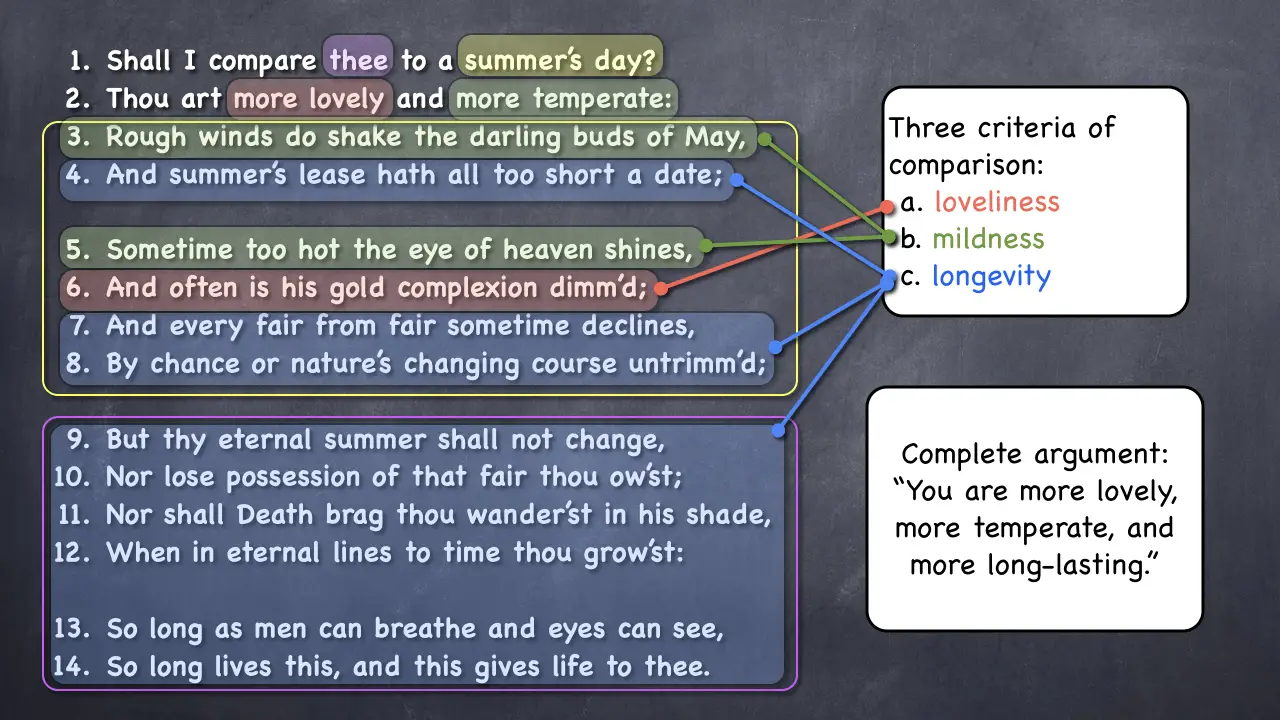
Indeed, Shakespeare provides a comparison, or more precisely, a contrast between “you” and the summer. And he uses beauty and mildness as criteria of comparison.
But as it turns out, the main criterion is not beauty or mildness. It is actually longevity. This means that in this sonnet, Shakespeare is more concerned with Time than with anything else.
He immortalizes the beauty of the subject by writing this sonnet. And as long as people read the sonnet, “you” are alive, meaning that time cannot destroy “you.”
And thus we have our analysis of the first source.
If you’d like a detailed analysis of sonnet 18, I created a whole tutorial on how this sonnet works. I highly recommend it because the tutorial will walk you through the process of analysis in a lot of detail.
And now let’s analyze the second sonnet.
Shakespeare’s sonnet 30
I picked this particular sonnet as the second main source because it shares the main subject and theme with sonnet 18. Let’s take a look:
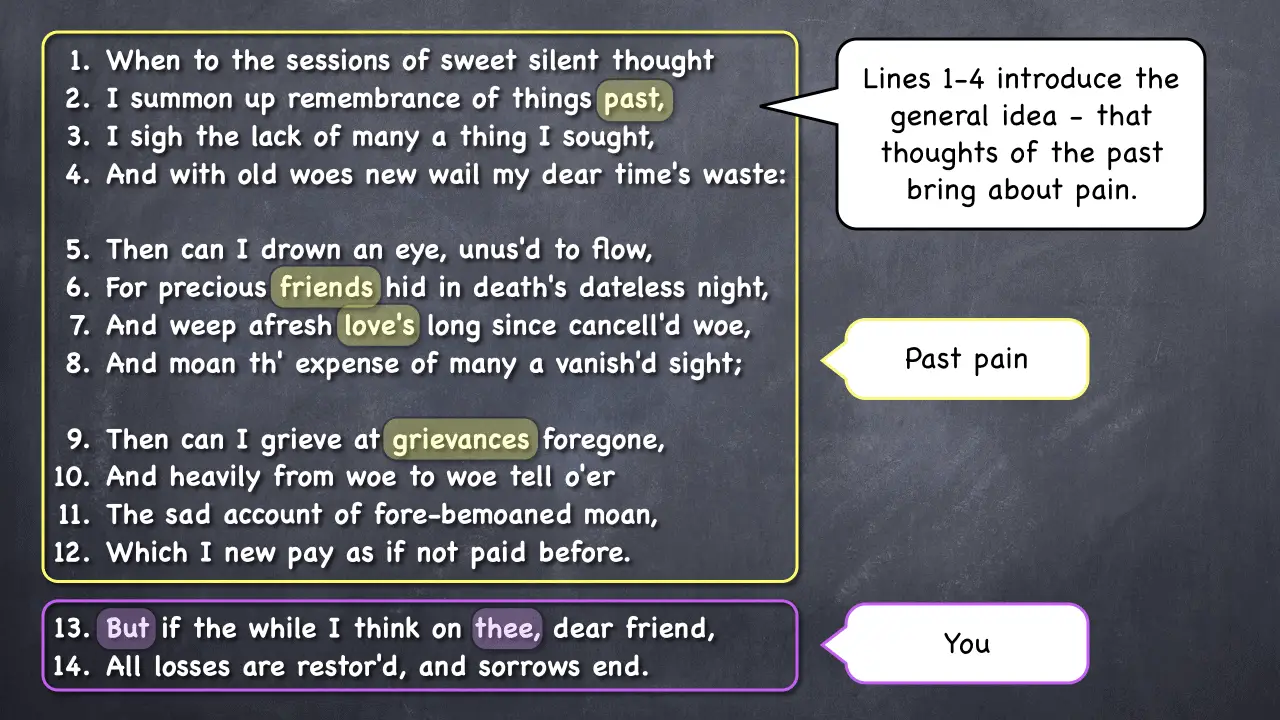
Similarly to sonnet 18, here Shakespeare introduces the main idea in the beginning (lines 1-4). The speaker clearly suffers when thinking about the past.
The main structure is also simple. Section 1 (lines 1-12) is devoted to the emotional pain associated with the remembrance of things past.
And section 2 (lines 13-14) is devoted to “you,” the real primary subject of the sonnet. Note that the word “But” in line 13 indicates a “turn” and introduces the second section, just like in sonnet 18.
To summarize the sonnet, the past brings the speaker pain, but thinking of “you” brings him relief.
And guess what – we’re done with step 1. And we’re ready for the next step.
Step 2. Form a new thesis based on the main ideas in the sources

In this step, we must put together one new main idea that will be the thesis of our synthesis essay.
We must derive this new main idea from the main ideas of the sources we just analyzed. This will be our synthesized main idea. This is where our synthesis begins.
Revisiting the Main Ideas from the Sources
We know that the two sonnets have some subjects and themes in common. Let’s take a look at their summaries together to have an overall picture.
In sonnet 18, Shakespeare is at war with time because it wants to kill “your” beauty. And his solution is the sonnet itself because it immortalizes “you.”
In sonnet 30, Shakespeare is also at war with time because the thoughts of the past bring him pain. And the solution is to think of “you” because this relieves the suffering.
We can see that in both sonnets, the author seems to be at war with time. But unlike in sonnet 18, where the enemy is the future, in sonnet 30 the enemy is the past.
Also, the solution in both sonnets is something or someone that is rooted in the present moment. In sonnet 18, this is the sonnet itself which immortalizes “you.” In sonnet 30, this is “you” because “you” provide the relief.
We can also see that the real subject of each sonnet, something or someone each sonnet is really about, is “you,” or the human being to whom the sonnets are addressed.
They both happen to be addressed to a man, as literary scholars agree.
And now we have all the information we need to form our own main point that will combine or synthesize the main arguments or ideas presented in the sonnets.
In fact, we have enough material to write out a complete thesis statement.
Let’s do it.
Synthesis Essay Thesis Statement Example
“In his sonnets, Shakespeare seems to be at war with Time. Sonnets 18 and 30 exemplify this idea very well. In sonnet 18, Shakespeare is at odds with time in terms of the future because it threatens to destroy the beauty of his beloved human being. In sonnet 30, time is again the foe, though the poet focuses on the past which brings him suffering. Finally, in both sonnets, the solution is something or someone rooted in the present moment which robs Time of its power to destroy beauty or cause pain.”
Note that the thesis statement essentially outlines our essay. It presents a big-picture structure that we can use to write it.
Our Synthesis Essay Structure
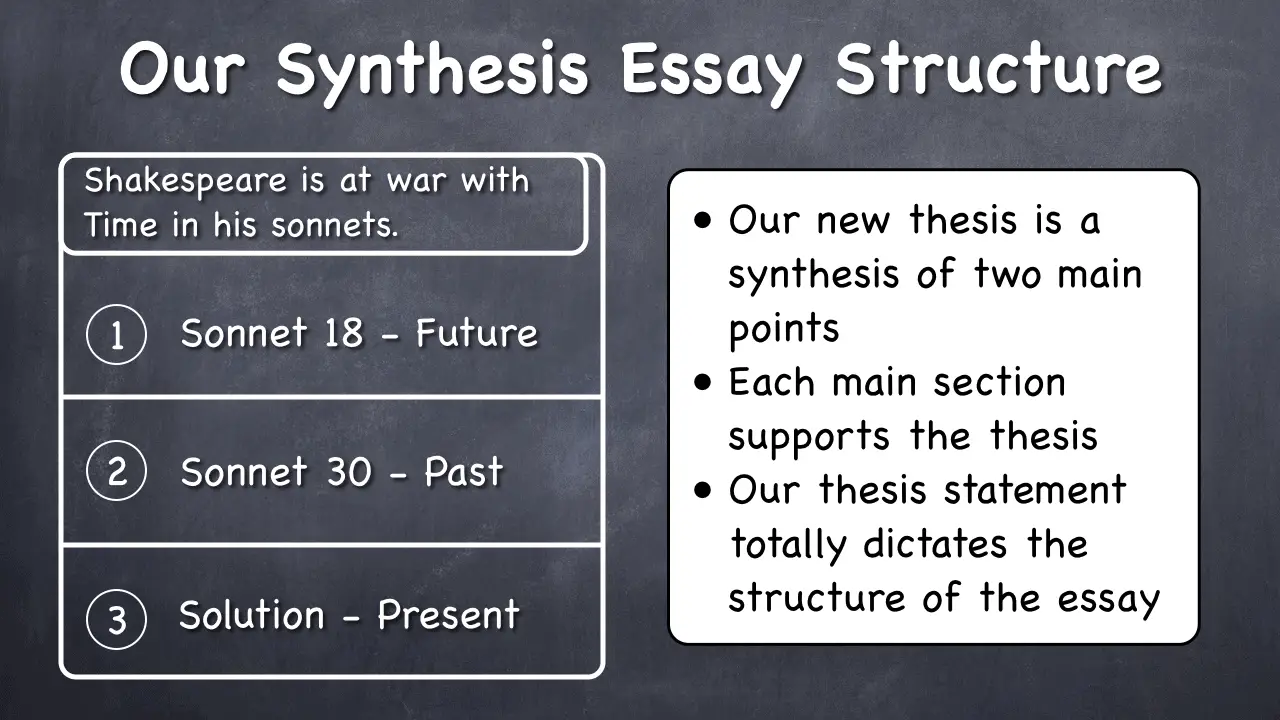
Our main point is derived from the main arguments in the two sonnets. Time is the unifying theme or idea.
The present moment is another unifying theme because the solutions to the problems are rooted in the present.
The man to whom the sonnets are addressed is a unifying subject, but that should be discussed somewhere in the body of the essay.
Here is something important. You may say, “but Phil, if Shakespeare is at war with Time, and the present is his solution, is that not contradictory? Isn’t the present also a form of Time?”
This would be a good philosophical question. And we can make it simple.
The past and the future are the destructive manifestations of time, in Shakespeare’s sonnets. But the present is where time really disappears. The present moment is the only place where there is no past or future.
And that’s why we have the present moment as the solution. In sonnet 18, the sonnet itself is the solution. And it exists now, untouched by time.
In sonnet 30, “you,” the subject of the poem, is the solution. And it exists now, in the time frame of the sonnet. Both are anchors of the present that rob Time of its destructive power.
And by the way, this is one excellent counterargument we can make somewhere in the body of the essay. It’s a great way to add content while improving the quality of the essay.
To learn more about the counterargument technique, watch this video I made earlier:
Guess what – we’re done with step 2 and now have a great, complete thesis statement! We also have our essay structure.
And now we’re ready for the final step.
Step 3. Write the rest of the essay, using ideas from the sources

We already have our thesis statement which also happens to be a perfect introduction paragraph. So now all we need is to write the body and the conclusion.
Writing the Body of a Synthesis Essay
The body of a synthesis essay consists of body paragraphs, just like in an argumentative essay.
To be clear, a synthesis essay is a type of an argumentative or expository essay. So, the way you would write a body paragraph is the same.
Here is how to structure a body paragraph in a synthesis essay:

A body paragraph proceeds from more general to more specific. It begins with a lead sentence, offers an explanation, and uses examples to illustrate the argument.
You can also use quotations – within your explanations and examples – to bring in some expert opinion.
Here is a key point about writing the body of a synthesis essay. Do not be concerned so much about where and how evidence is presented in the sources.
But organize and reorganize that evidence as you see fit as long as it serves to prove your new main point.
However Shakespeare chose to structure his sonnets was his business. How we choose to structure our synthesis essay is our business.
This means that we can pull a piece of information from any part of either sonnet and use it to support our point anywhere in our essay.
When we do that, we are simply putting together a unique piece of content that is different from the original sources but based on them.
To do this effectively, a detailed outline would really help. So, let’s create one.
Synthesis Essay Outline
- Introductory paragraph
- Section 1. Sonnet 18 – Shakespeare vs time in terms of the future
- The summer’s beauty fades fast
- Compared to it, “you” are immortal
- Section 2. Sonnet 30 – Shakespeare vs time in terms of the past
- Thinking of the past brings suffering
- The poet:
- Laments friends and lovers who are dead
- Relives old grievances
- Section 3. The Present as the solution
- “You” are immortalized by this sonnet that exists in the present
- The solution is the sonnet
- It is rooted in the present
- The solution is “you” who are rooted in the present
- The solution is “you”
- “You” are rooted in the present
- “You” are immortalized by this sonnet that exists in the present
- Conclusion
We now have everything we need to write our sample body paragraph. Our first section is devoted to sonnet 18. Note that we have more than one paragraph in each section.
Let’s write out Section 1 – Paragraph 1 – about Shakespeare being at war with the future.
Sample Body Paragraph in a Synthesis Essay
“In sonnet 18, Shakespeare is at war with time because as it proceeds into the future, it destroys beauty. Beauty is important to Shakespeare, as is evident in line 2 where he declares his intention to compare the subject, ‘you,’ with the summer, in terms of beauty and mildness. The protest against time begins in line 4, where the poet states that the summer has ‘all too short a date.’ Then, Shakespeare picks it back up again in lines 7-8, where he laments that any beauty must end sooner or later, either by chance or by the eternal law of change.”
Note several things about this paragraph:
- It focuses on one subject that we have in our outline
- The subject is the summer and its mortality
- It begins with a lead sentence which summarizes the paragraph perfectly
- It proceeds to an explanation why beauty is important in this sonnet
- It employs examples from particular lines, including a direct quotation
- It is 101 words long, which is a healthy length for a body paragraph
To complete writing the body of this essay, we would need to write 8-10 such paragraphs. Each one should correspond to the outline and have the body paragraph structure provided above.
When the body paragraphs are finished, it’s time to write the conclusion.
The Conclusion
I always advocate to conclude an argumentative essay with simple restatement. It’s a time-proven technique that works and is easy to implement.
Essentially, you copy the structure of your thesis statement but not the words used in it. In other words, rewrite your thesis statement using different words and phrases.
Let’s do it:
“Shakespeare’s sonnets have an important theme in common – they seem to resist time. In sonnet 18, the poet laments the ever-changing quality of nature driven by time into the future. Future represents the death of beauty, potentially the beauty of his object of affection. In sonnet 30, the past is the challenger because it brings about suffering. But Shakespeare finds a way to rob time of its destructive power. He uses subjects that are based in the present moment to effectively counter time’s evil intent.”
And there you have it. This is how you write a synthesis essay.
Hope this was helpful. And if you happen to struggle with essay writing in general or need a good refresher, definitely check out this tutorial I wrote on essay writing for beginners.
Now go ahead and write that amazing synthesis essay!
Tutor Phil
